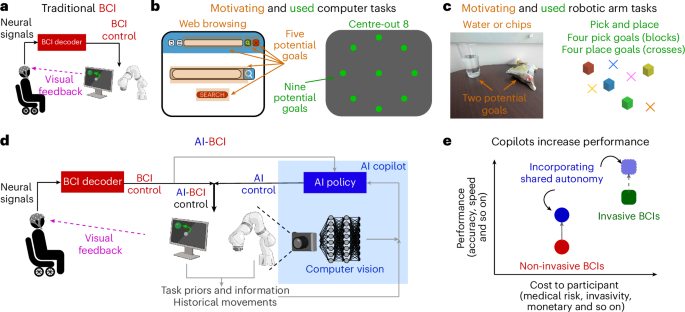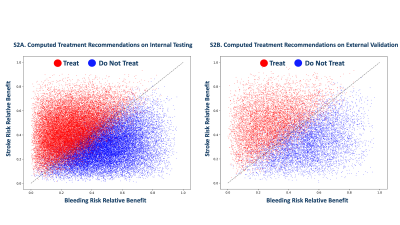Hochberg, L. R. et al. Neuronal ensemble control of prosthetic devices by a human with tetraplegia. Nature 442, 164–171 (2006).
Google Scholar
Gilja, V. et al. Clinical translation of a high-performance neural prosthesis. Nat. Med. 21, 1142–1145 (2015).
Google Scholar
Pandarinath, C. et al. High performance communication by people with paralysis using an intracortical brain-computer interface. eLife 6, e18554 (2017).
Google Scholar
Hochberg, L. R. et al. Reach and grasp by people with tetraplegia using a neurally controlled robotic arm. Nature 485, 372–375 (2012).
Google Scholar
Collinger, J. L. et al. High-performance neuroprosthetic control by an individual with tetraplegia. Lancet 381, 557–564 (2013).
Google Scholar
Wodlinger, B. et al. Ten-dimensional anthropomorphic arm control in a human brain-machine interface: difficulties, solutions, and limitations. J. Neural Eng. 12, 016011 (2015).
Google Scholar
Aflalo, T. et al. Decoding motor imagery from the posterior parietal cortex of a tetraplegic human. Science 348, 906–910 (2015).
Google Scholar
Edelman, B. J. et al. Noninvasive neuroimaging enhances continuous neural tracking for robotic device control. Sci. Robot. 4, eaaw6844 (2019).
Google Scholar
Reddy, S., Dragan, A. D. & Levine, S. Shared autonomy via deep reinforcement learning. In Proc. Robotics: Science and Systems https://doi.org/10.15607/RSS.2018.XIV.005 (RSS, 2018).
Laghi, M., Magnanini, M., Zanchettin, A. & Mastrogiovanni, F. Shared-autonomy control for intuitive bimanual tele-manipulation. In 2018 IEEE-RAS 18th International Conference on Humanoid Robots (Humanoids) 1–9 (IEEE, 2018).
Tan, W. et al. On optimizing interventions in shared autonomy. In Proc. AAAI Conference on Artificial Intelligence 5341–5349 (AAAI, 2022).
Yoneda, T., Sun, L., Yang, G., Stadie, B. & Walter, M. To the noise and back: diffusion for shared autonomy. In Proc. Robotics: Science and Systems https://doi.org/10.15607/RSS.2023.XIX.014 (RSS, 2023).
Peng, Z., Mo, W., Duan, C., Li, Q. & Zhou, B. Learning from active human involvement through proxy value propagation. Adv. Neural Inf. Process. Syst. 36, 20552–20563 (2023).
Google Scholar
McMahan, B. J., Peng, Z., Zhou, B. & Kao, J. C. Shared autonomy with IDA: interventional diffusion assistance. Adv. Neural Inf. Process. Syst. 37, 27412–27425 (2024).
Shannon, C. E. Prediction and entropy of printed English. Bell Syst. Tech. J. 30, 50–64 (1951).
Karpathy, A., Johnson, J. & Fei-Fei, L. Visualizing and understanding recurrent networks. In International Conference on Learning Representations https://openreview.net/pdf/71BmK0m6qfAE8VvKUQWB.pdf (ICLR, 2016).
Radford, A. et al. Language models are unsupervised multitask learners. OpenAI https://cdn.openai.com/better-language-models/language_models_are_unsupervised_multitask_learners.pdf (2019).
Gilja, V. et al. A high-performance neural prosthesis enabled by control algorithm design. Nat. Neurosci. 15, 1752–1757 (2012).
Google Scholar
Dangi, S., Orsborn, A. L., Moorman, H. G. & Carmena, J. M. Design and analysis of closed-loop decoder adaptation algorithms for brain-machine interfaces. Neural Comput. 25, 1693–1731 (2013).
MathSciNet
Google Scholar
Orsborn, A. L. et al. Closed-loop decoder adaptation shapes neural plasticity for skillful neuroprosthetic control. Neuron 82, 1380–1393 (2014).
Google Scholar
Silversmith, D. B. et al. Plug-and-play control of a brain–computer interface through neural map stabilization. Nat. Biotechnol. 39, 326–335 (2021).
Google Scholar
Kim, S.-P., Simeral, J. D., Hochberg, L. R., Donoghue, J. P. & Black, M. J. Neural control of computer cursor velocity by decoding motor cortical spiking activity in humans with tetraplegia. J. Neural Eng. 5, 455 (2008).
Google Scholar
Sussillo, D. et al. A recurrent neural network for closed-loop intracortical brain–machine interface decoders. J. Neural Eng. 9, 026027 (2012).
Google Scholar
Sussillo, D., Stavisky, S. D., Kao, J. C., Ryu, S. I. & Shenoy, K. V. Making brain–machine interfaces robust to future neural variability. Nat. Commun. 7, 13749 (2016).
Google Scholar
Kao, J. C. et al. Single-trial dynamics of motor cortex and their applications to brain-machine interfaces. Nat. Commun. 6, 7759 (2015).
Google Scholar
Kao, J. C., Nuyujukian, P., Ryu, S. I. & Shenoy, K. V. A high-performance neural prosthesis incorporating discrete state selection with hidden Markov models. IEEE Trans. Biomed. Eng. 64, 935–945 (2016).
Google Scholar
Shenoy, K. V. & Carmena, J. M. Combining decoder design and neural adaptation in brain-machine interfaces. Neuron 84, 665–680 (2014).
Google Scholar
Lawhern, V. J. et al. EEGNet: a compact convolutional neural network for EEG-based brain–computer interfaces. J. Neural Eng. 15, 056013 (2018).
Google Scholar
Forenzo, D., Zhu, H., Shanahan, J., Lim, J. & He, B. Continuous tracking using deep learning-based decoding for noninvasive brain–computer interface. PNAS Nexus 3, pgae145 (2024).
Google Scholar
Pfurtscheller, G. & Da Silva, F. L. Event-related EEG/MEG synchronization and desynchronization: basic principles. Clin. Neurophysiol. 110, 1842–1857 (1999).
Google Scholar
Olsen, S. et al. An artificial intelligence that increases simulated brain–computer interface performance. J. Neural Eng. 18, 046053 (2021).
Google Scholar
Schulman, J., Wolski, F., Dhariwal, P., Radford, A. & Klimov, O. Proximal policy optimization algorithms. Preprint at https://arxiv.org/abs/1707.06347 (2017).
Liu, S. et al. Grounding DINO: marrying DINO with grounded pre-training for open-set object detection. In 18th European Conference 38–55 (ACM, 2024).
Golub, M. D., Yu, B. M., Schwartz, A. B. & Chase, S. M. Motor cortical control of movement speed with implications for brain-machine interface control. J. Neurophysiol. 112, 411–429 (2014).
Google Scholar
Sachs, N. A., Ruiz-Torres, R., Perreault, E. J. & Miller, L. E. Brain-state classification and a dual-state decoder dramatically improve the control of cursor movement through a brain-machine interface. J. Neural Eng. 13, 016009 (2016).
Google Scholar
Kao, J. C., Nuyujukian, P., Ryu, S. I. & Shenoy, K. V. A high-performance neural prosthesis incorporating discrete state selection with hidden Markov models. IEEE Trans. Biomed. Eng. 64, 935–945 (2017).
Google Scholar
Stieger, J. R. et al. Mindfulness improves brain–computer interface performance by increasing control over neural activity in the alpha band. Cereb. Cortex 31, 426–438 (2021).
Google Scholar
Stieger, J. R., Engel, S. A. & He, B. Continuous sensorimotor rhythm based brain computer interface learning in a large population. Sci. Data 8, 98 (2021).
Google Scholar
Edelman, B. J., Baxter, B. & He, B. EEG source imaging enhances the decoding of complex right-hand motor imagery tasks. IEEE Trans. Biomed. Eng. 63, 4–14 (2016).
Google Scholar
Scherer, R. et al. Individually adapted imagery improves brain-computer interface performance in end-users with disability. PLoS ONE 10, e0123727 (2015).
Google Scholar
Millan, J. d. R. et al. A local neural classifier for the recognition of EEG patterns associated to mental tasks. IEEE Trans. Neural Netw. 13, 678–686 (2002).
Google Scholar
Huang, D. et al. Decoding subject-driven cognitive states from EEG signals for cognitive brain–computer interface. Brain Sci. 14, 498 (2024).
Google Scholar
Meng, J. et al. Noninvasive electroencephalogram based control of a robotic arm for reach and grasp tasks. Sci. Rep. 6, 38565 (2016).
Google Scholar
Jeong, J.-H., Shim, K.-H., Kim, D.-J. & Lee, S.-W. Brain-controlled robotic arm system based on multi-directional CNN-BiLSTM network using EEG signals. IEEE Trans. Neural Syst. Rehabil. Eng. 28, 1226–1238 (2020).
Google Scholar
Zhang, R. et al. NOIR: neural signal operated intelligent robots for everyday activities. In Proc. 7th Conference on Robot Learning 1737–1760 (PMLR, 2023).
Jeon, H. J., Losey, D. P. & Sadigh, D. Shared autonomy with learned latent actions. In Proc. Robotics: Science and Systems https://doi.org/10.15607/RSS.2020.XVI.011 (RSS, 2020).
Javdani, S., Bagnell, J. A. & Srinivasa, S. S. Shared autonomy via hindsight optimization. In Proc. Robotics: Science and Systems https://doi.org/10.15607/RSS.2015.XI.032 (RSS, 2015).
Newman, B. A. et al. HARMONIC: a multimodal dataset of assistive human-robot collaboration. Int. J. Robot. Res. 41, 3–11 (2022).
Jain, S. & Argall, B. Probabilistic human intent recognition for shared autonomy in assistive robotics. ACM Trans. Hum. Robot Interact. 9, 2 (2019).
Google Scholar
Losey, D. P., Srinivasan, K., Mandlekar, A., Garg, A. & Sadigh, D. Controlling assistive robots with learned latent actions. In 2020 IEEE International Conference on Robotics and Automation (ICRA) 378–384 (IEEE, 2020).
Cui, Y. et al. No, to the right: online language corrections for robotic manipulation via shared autonomy. In Proc. 2023 ACM/IEEE International Conference on Human-Robot Interaction 93–101 (ACM, 2023).
Karamcheti, S. et al. Learning visually guided latent actions for assistive teleoperation. In Proc. 3rd Conference on Learning for Dynamics and Control 1230–1241 (PMLR, 2021).
Chi, C. et al. Diffusion policy: visuomotor policy learning via action diffusion. Int. J. Rob. Res. https://doi.org/10.1177/02783649241273668 (2024).
Brohan, A. et al. RT-1: robotics transformer for real-world control at scale. In Proc. Robotics: Science and Systems https://doi.org/10.15607/RSS.2023.XIX.025 (RSS, 2023).
Brohan, A. et al. RT-2: vision-language-action models transfer web knowledge to robotic control. In Proc. 7th Conference on Robot Learning 2165–2183 (PMLR, 2023).
Nair, S., Rajeswaran, A., Kumar, V., Finn, C. & Gupta, A. R3M: a universal visual representation for robot manipulation. In Proc. 6th Conference on Robot Learning 892–909 (PMLR, 2023).
Ma, Y. J. et al. VIP: towards universal visual reward and representation via value-implicit pre-training. In 11th International Conference on Learning Representations https://openreview.net/pdf?id=YJ7o2wetJ2 (ICLR, 2023).
Khazatsky, A. et al. DROID: a large-scale in-the-wild robot manipulation dataset. In Proc. Robotics: Science and Systems https://doi.org/10.15607/RSS.2024.XX.120 (RSS, 2024).
Open X-Embodiment Collaboration. Open X-Embodiment: robotic learning datasets and RT-X models. In 2024 IEEE International Conference on Robotics and Automation (ICRA) 6892–6903 (IEEE, 2024).
Willett, F. R. et al. A high-performance speech neuroprosthesis. Nature 620, 1031–1036 (2023).
Google Scholar
Leonard, M. K. et al. Large-scale single-neuron speech sound encoding across the depth of human cortex. Nature 626, 593–602 (2024).
Google Scholar
Card, N. S. et al. An accurate and rapidly calibrating speech neuroprosthesis. N. Engl. J. Med. 391, 609–618 (2024).
Google Scholar
Sato, M. et al. Scaling law in neural data: non-invasive speech decoding with 175 hours of EEG data. Preprint at https://arxiv.org/abs/2407.07595 (2024).
Kaifosh, P., Reardon, T. R. & CTRL-labs at Reality Labs. A generic non-invasive neuromotor interface for human–computer interaction. Nature https://doi.org/10.1038/s41586-025-09255-w (2025).
Zeng, H. et al. Semi-autonomous robotic arm reaching with hybrid gaze-brain machine interface. Front. Neurorobot. 13, 111 (2019).
Google Scholar
Shafti, A., Orlov, P. & Faisal, A. A. Gaze-based, context-aware robotic system for assisted reaching and grasping. In 2019 International Conference on Robotics and Automation 863–869 (IEEE, 2019).
Argall, B. D. Autonomy in rehabilitation robotics: an intersection. Annu. Rev. Control Robot. Auton. Syst. 1, 441–463 (2018).
Google Scholar
Nuyujukian, P. et al. Monkey models for brain-machine interfaces: the need for maintaining diversity. In Proc. 33rd Annual Conference of the IEEE EMBS 1301–1305 (IEEE, 2011).
Suminski, A. J., Tkach, D. C., Fagg, A. H. & Hatsopoulos, N. G. Incorporating feedback from multiple sensory modalities enhances brain-machine interface control. J. Neurosci. 30, 16777–16787 (2010).
Google Scholar
Kaufman, M. T. et al. The largest response component in motor cortex reflects movement timing but not movement type. eNeuro 3, ENEURO.0085–16.2016 (2016).
Google Scholar
Dangi, S. et al. Continuous closed-loop decoder adaptation with a recursive maximum likelihood algorithm allows for rapid performance acquisition in brain-machine interfaces. Neural Comput. 26, 1811–1839 (2014).
Google Scholar
Fitts, P. M. The information capacity of the human motor system in controlling the amplitude of movement. J. Exp. Psychol. 47, 381 (1954).
Google Scholar
Gramfort, A. et al. MNE software for processing MEG and EEG data. NeuroImage 86, 446–460 (2014).
Google Scholar
Lee, J. Y. et al. Data: brain–computer interface control with artificial intelligence copilots. Zenodo https://doi.org/10.5281/zenodo.15165133 (2025).
Lee, J. Y. et al. kaolab-research/bci_raspy. Zenodo https://doi.org/10.5281/zenodo.15164641 (2025).
Lee, J. Y. et al. kaolab-research/bci_plot. Zenodo https://doi.org/10.5281/zenodo.15164643 (2025).







 The stakes couldn’t be higher. Native languages are being lost at an alarming rate. Food insecurity plagues many tribal communities. But solutions are emerging, and these stories need to be told.
The stakes couldn’t be higher. Native languages are being lost at an alarming rate. Food insecurity plagues many tribal communities. But solutions are emerging, and these stories need to be told.

















